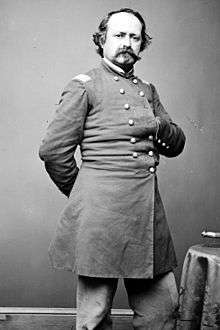Charles H. Larrabee
| Charles H. Larrabee | |
|---|---|
 | |
| Member of the U.S. House of Representatives from Wisconsin's 3rd district | |
|
In office March 4, 1859 – March 3, 1861 | |
| Preceded by | Charles Billinghurst |
| Succeeded by | A. Scott Sloan |
| Personal details | |
| Born |
November 9, 1820 Rome, New York |
| Died |
January 20, 1883 (aged 62) Tehachapi, California |
| Political party | Democratic |
| Military service | |
| Allegiance |
United States of America Union |
| Service/branch | Union Army |
| Years of service | 1861-1863 |
| Rank | Colonel |
| Battles/wars | American Civil War |
Charles Hathaway Larrabee (November 9, 1820 – January 20, 1883) was a U.S. Representative from Wisconsin. He was also a lawyer and U.S. Army officer.
Personal
Larrabee was born in Rome, New York, on November 9, 1820, the son of Charles Larrabee of Connecticut. His family moved to Cincinnati, Ohio, where young Charles attended Springfield Academy and then Granville College from 1834 to 1836. At Granville he specialized in English studies, mathematics and ancient languages.[1]:4[2] Later, he read law with Samson Mason and W.A. Rogers in Springfield, Ohio.[1]:4
He resided in New York, Ohio, Mississippi, Illinois, Wisconsin, California, Oregon and Washington Territory.[1]
In 1846, he married Minerva Norton, and they moved to Horicon, Wisconsin.[1]:4 Minerva died in San Francisco in 1873 at age 50.[2][3]
Larrabee was killed in a train accident at the Tehachapi Loop near Tehachapi, California, on January 20, 1883.[4][5] He was survived by a son and daughter.[1]:23 Interment was in the Masonic Cemetery, San Francisco.[6]
An attempt was made in the settlement of his estate to show that the claim by his second wife was not legitimate, but she produced a marriage certificate and letters to show that it was, and the marriage was therefore allowed in San Bernardino Superior Court.[7] In June 1884, John Anderson, executor of Larrabee's estate, filed a court action in San Bernardino against the Central Pacific Railroad, asking $100,000 in damages.[8]
Career
Pre-war
Before becoming a lawyer, Larrabee worked as an engineer and helped survey the Little Miami Railroad.[2] He was admitted to the bar in September 1841 and in the same year ran unsuccessfully for the Mississippi State Legislature; then, moving to Chicago, he edited the Democratic Advocate and became city attorney there.[1]:4
After moving to Wisconsin in 1847, Dodge County, Wisconsin voters chose him as one of their three representatives to the state's second constitutional convention that same year. His chief preoccupation there was establishing a homestead exemption that would aid poor people. In 1848 he was elected a circuit court judge, which position made him a member of the state supreme court, the youngest person ever to serve on that court; he stayed ten years.[1]:4–6[2]
In 1852 he was nominated as the Democratic candidate for chief justice, but failed in the election against "the older and more experienced" Edward V. Whiton. He was, however, elected to Congress in 1858, representing the district with the largest population in the country, 350,000 people.[1]:6[2]
Military
After the outbreak of the U.S. Civil War, Larrabee enlisted as a private in the Horicon Guard militia, where he was elected to be a second lieutenant. As a regular, he was commissioned as a major by Governor Randall with the 5th Wisconsin, and later he was promoted to colonel and given command of the 24th Wisconsin. Disease, however, forced him to resign his commission in August 1863.[1]:9–17, 21[2]
Postwar
His illnesses were diarrhea and erysipelas in the head, and he sought relief in the climates of California, Nevada and Oregon, and then, with Beriah Brown, to Washington Territory, where he became a member of a state constitutional convention. In Washington also he helped to organize a state university in Seattle.[1]:23
In 1868 he was in Los Angeles, California, where he and William A. Winder, the former commander of the U.S. prison on Alcatraz Island, opened an agency "for the purchase and sale of lands in the southern part of the state."[9][10] In April 1868 he was elected city attorney. None of the officials elected at that time served, however, and the election "seems to have been wholly ignored."[11] Larrabee eventually settled in San Bernardino, California, where he resumed his law practice.[1]:23
References and notes
- 1 2 3 4 5 6 7 8 9 10 11 Lyman C. Draper, A Biographical Sketch of Hon. Charles H. Larrabee
- 1 2 3 4 5 6 Wisconsin Court System website
- ↑ "Died," Daily Alta California, August 8, 1873
- ↑ The New York Times, January 22, 1883, at GenDisasters.com, screen 2
- ↑ "The Southern Pacific Horror," Daily Globe, January 22, 1883, page 1
- ↑ Biographical Directory of the United States Congress
- ↑ "The Larrabee Case Settled," San Bernardino Times, as reprinted in Los Angeles Herald, August 26, 1884. The first name of the widow was not reported.
- ↑ "A Victim of the Tehachapi Horror," Daily Alta California, June 5, 1884
- ↑ "Editorial Notes: Land Agency," Daily Alta California, May 14, 1868
- ↑ "Around the Corridors," San Francisco Call, April 12, 1895
- ↑ Chronological Record of Los Angeles City Officials 1850–1938, Municipal Reference Library, March 1938, reprinted 1946
Further reading
- Testament to Larrabee after his death, San Bernardino Times, quoted in "Col. C.H. Larrabee," Los Angeles Herald, January 26, 1883
External links
| United States House of Representatives | ||
|---|---|---|
| Preceded by Charles Billinghurst |
Member of the U.S. House of Representatives from Wisconsin's 3rd congressional district March 4, 1859 - March 3, 1861 |
Succeeded by A. Scott Sloan |